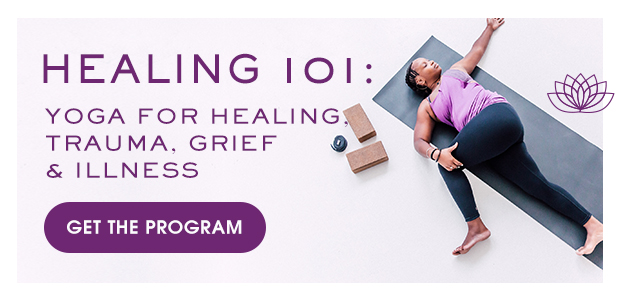The science of yoga holds potent healing powers. This post will help you learn how to heal emotional trauma with yoga.
“Healing doesn’t mean pain never existed. It means the damage no longer controls our lives.”
People have been practicing yoga for thousands of years. While the original purpose was to elevate to a greater spiritual level, it is clear that yoga benefits the person as a whole. Yoga is not just an ‘exercise', it's a way of thinking that focuses on a union of the entire self – mind, body, and spirit.
Yes, yoga does improve your body, but surprising scientific research has shown that it changes the brain, as well. It's about becoming a better version of yourself and getting in touch with acceptance. A better, more fulfilled life is within our reach when we let go and accept what is there.
Studies have proven that practicing yoga can provide tremendous relief for people suffering from trauma, loss or grief.
The wisdom of yoga can assist you in releasing the pain of past feelings. Yoga helps to unlock the body where emotions are stored so you can step forward toward a new life with heightened perspective.
Here's how to heal from emotional trauma with yoga
How to Heal Emotional Trauma
1. Perform Yoga Asanas
If you are dealing with emotional trauma, a yoga mat can become your space of intense release. There are several ‘opening’ yoga postures that touch the body parts containing blocked energies. These poses allow you to release those blocked energies and get rid of the old wounds to begin the healing process.
Add a few nurturing and calming restorative yoga asanas into your daily regimen to stimulate the relaxation response in the body. Relaxation poses allow the body to release muscle tensions, balance stress hormones and decrease heart rate. As you hold and balance yourself in the poses, you start to learn to control your mind and to release suppressed emotions.
With yoga, you can empower yourself and embark the path of healing.
Bound Angle Pose (Baddha Konasana):
 A great yoga asana to perform to release the pelvis. When you feel threatened, the pelvis binds, so you can practice Angle this pose to help in the opening of your hips and pelvis.
A great yoga asana to perform to release the pelvis. When you feel threatened, the pelvis binds, so you can practice Angle this pose to help in the opening of your hips and pelvis.
Upward-Facing Dog (Urdhva-Mukha Svanasana):

The throat becomes the place of locked emotions when you hold back your emotions. Upward-Facing Dog rushes clear energy into the throat through the legs and arch of the spine, flushing out blockages.
Headstand (Sirsasana):
 Headstand posture strengthens the muscles of the neck and the erect spine helps in improving the posture. As this pose requires strong focus, it encourages you to stay present without dwelling in the past.
Headstand posture strengthens the muscles of the neck and the erect spine helps in improving the posture. As this pose requires strong focus, it encourages you to stay present without dwelling in the past.
2. Meditation

Emotional trauma damages the insula. This is the part of the brain responsible for producing an emotional context for sensory experience. Also, the prefrontal cortex which supports us in self-regulation.
After experiencing trauma, due to the weakening of these brain areas, you may feel lost and in a state of chronic stress. Meditation can help you find a calm place and a deeper connection with the self.
It can be incredibly difficult to sit for long periods in meditation with emotional pain, so start with shorter periods, if you like. But committing to it will begin the healing process. When you feel in union and rejuvenated, you gain self-control and act with diligence.
Meditation nourishes the insula and prefrontal cortex which strengthens the mind-body connection.
Meditation can involve:
- Mantra chanting – Chant sacred mantras to detach the mind from negative emotions to experience calm within.
- Breathing – Concentrate on deep breathing to bring the mind in the present state. In the state of awareness, the mind let goes of the old patterns.
- Focusing that fosters relaxation – This is guided meditation where an instructor guides you how to meditate via verbal cues to promote healing, stillness, and connection with the true self.
3. Practice Deep Breathing

Trauma survivors take shallow breaths that affect their physical, mental and spiritual health. Deep breathing through Pranayama practices can help you:
- Unlock blocked channels and energy centers
- Improve the quality of prana
- Nurture the organs
- Savor the present moment
As we consciously inhale, prana flows to the regions where the emotions are stuck so you can let go of the emotional weight.
In Pranayama practice, you are encouraged to maintain the focus that allows you to bring your awareness to love and guidance.
- Kapal Bhati Pranayama: Through forceful exhalation, this technique stimulates and moves emotions that lay in the surface of the body.
- Dirga Pranayama: It brings attention to the emotions trapped in the hips, stomach, and chest and assist in the release of the trapped feelings.
- Ujjayi Pranayama: In this breathing technique, as you make the ‘Ha’ sound, you release the fear and anger.
4. Adopt the Principle of Pratyahara
While practicing the yoga, keep your focus on sensations of the body amidst the emotional thoughts so that you can release them.
Sometimes current circumstances are painful, difficult, and seemingly unbearable. Loss and grief affect us physically, not just emotionally or mentally. The pain sits in our tissues and if left untended can result in blocks and stuck negative energy. But by practicing yoga and mindfulness, we can help ourselves work through whatever is going on, whether it is loss of a loved one, illness, or trauma.
Yoga can help you empower yourself and tap into your inner resiliency and strength in such a way that you can continue moving forward in your life despite seemingly insurmountable obstacles. Yoga reminds us that everything is temporary. Everything. Accepting the concept of impermanence can help us adjust to illness, loss, and grief.
A directed yoga practice can do the same. This is why Yoga Download has launched a new class program: Healing 101: Yoga for Trauma, Grief, & Illness. This package is ideal for anyone experiencing these life challenges. There are classes specific to each unique challenge (trauma, loss, grief, or illness), as well as classes applicable to overall healing, regardless of your current battle. Classes are gentler and centered on giving you a safe space to move through your emotions and heal.
WHO IS THIS FOR?
- Any level of practitioner
- Those struggling with loss, illness, or any sort of trauma
- Anyone going through a tough time
- Those suffering from anxiety or depression
- Anyone navigating illness
WHAT YOU WILL LEARN AND EXPERIENCE:
- How to cope with challenging times
- You will experience some gentle relief from the weight of your struggles
- A space to process difficult emotions in a healthy way
- A chance to allow yourself to feel
- Yoga practices you can return to, whenever you’re feeling overwhelmed by your challenges





A very nice article.
I will definitely try this out
Thank you. So pleased you found it helpful!
Great blog. Thank you for sharing this one.
Ayurveda School in Kerala
Hi ,Thanks for the post ,
This is very informative content about yoga in our life .Yoga plays a vital role in maintaining both physical and mental well-being. It enhances flexibility, strength, and balance by engaging the body in mindful movements. Practicing yoga regularly helps reduce stress, anxiety, and depression by promoting relaxation and mindfulness. It improves respiratory function, boosts immunity, and enhances circulation, contributing to overall health.Lords Ayurveda institute in Kerala and Research Center is the top Ayurveda and Panchakarma Institute in India.Our school kerala offers traditional Ayurvedic therapies and ayurveda, online panchakarma course and yoga courses.